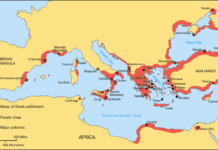A summary of the Battle of Plataea, which effectively ended the Persian Invasion of 480 B.C.E
After Salamis
After the Battle of Salamis in 480 B.C.E, Xerxes returned to Persia, withdrawing his battered navy from Greek waters. The army of the Great King, however, remained in Attica, under the control of Persian General Mardonius.[1]
The campaigning season had come to an end, and it was not until the next summer that the Greeks again allied their forces to face the Persian army. This allied force came to be largest ever yet mustered by the Greeks. According to Hanson, in his book Warfare of The Ancient Greeks, ‘a force of at least sixty thousand heavy infantry, and perhaps an equal number of lightly-armed auxiliaries—even Alexander the Great never yielded forces of such size.’ Despite the great size of the Greek force, it was still heavily outnumbered by the Persian army. [2]
The Battle
In the summer of 479, the Greeks met Mardonius near the city Plataea, in Boeotia. There, led by Spartan King Pausinias ensued the Battle of Plataea.[3]
Effectively, the Greek force was made mainly by Spartan and Athenian armies, but there was also various armies from the Peloponnese.
Spread out on a wide, flat plain, Spartan hoplites were on the right wing, the Athenians on the left. The Peloponnese occupied the middle of these two great armies.
Mardonius immediately attacked the Spartans, for it was both an acknowledged and proved fact that the Spartans were the greatest military land power in Greece, just as the Athenians were the greatest naval power. If he, Mardonius, could defeat the Spartans, he would deliver a blow not only to the Greek army, but also—and perhaps more fatally—to the Greek morale. If the best fighting force the Greeks had to offer was defeated, then what hope could be held out? Unlike the Battle of Thermopylae, where Spartan defeat had given defiant pride to the Greeks, there would be no such chance of that at Plataea.
As well as a larger army, the other thing that gave Mardonius a definite edge was the existence of elite Persian cavalry. The Greeks had nothing to match the caliber of the horsemen; all they had were the οπλ?της, or in the English alphabet and language, the hoplites.
As the Persian cavalry rode against the Spartans, the Boeotians—who had Medized—marched against the Athenians.[4] According to the plan of Mardonius, this was a set, engaged battle. He thought the Hellenic army would fall quickly to his superiorly-vast army.
This, however, was not to be the case. ‘The Spartans, and the nearby men of Tegea endured repeated cavalry and archery attacks…’ as so says Hanson. Eventually, the Greeks pushed the Persians back, back into the Asopus river.
The End of the Battle
The Persians were effectively condemned to defeat when Mardonius was killed in battle. After his death, the Persians quickly dropped back in the right wing, and then collapsed. When the Boeotians fighting the Athenians in the left wing, they surrendered.
Despite all odds, the Greeks had won.
The Conclusion
Just as the Battle of Salamis was a definitive turning point to the Persian Invasion of 480, the Battle of Plataea was an effective end of it. After one small battle at Mycale, it was without a doubt: the Persians Invasion had been defied by the forces of Allied Greece.
Sources:
- Hanson, Victor Davis: Wars of the Ancient Greeks. New York: Harper Collins, 2004
- [1] Victor Davis Hanson, Wars of the Ancient Greeks (New York, HaperCollins Publishers, 2004), 103
- [2] Victor Davis Hanson, Wars of the Ancient Greeks (New York, HaperCollins Publishers, 2004), 103-04
- [3] Joseph Berrigan, The Battle of Plataea, http://joseph_berrigan.tripod.com/ancientbabylon/id30.html
- [4] Victor Davis Hanson, Wars of the Ancient Greeks (New York, HaperCollins Publishers, 2004), 107








